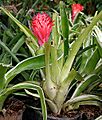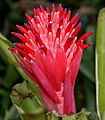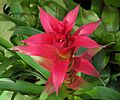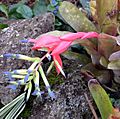Bromeliad facts for kids
Quick facts for kids Bromeliaceae |
|
|---|---|
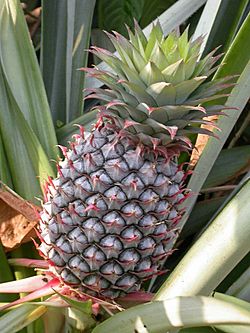 |
|
| Pineapple, one member of the Bromeliaceae family | |
| Scientific classification | |
| Kingdom: | |
| Division: | |
| Class: | |
| Order: | |
| Family: |
Bromeliaceae
|
| Subfamiles | |
|
|
Bromeliads are a fascinating family of tropical plants. They are known for their bright colors and interesting shapes. This plant family includes the pineapple and many popular houseplants. Most bromeliads grow naturally in Latin America and the Caribbean islands. One type, called Spanish moss, is found in the southern United States. There is also one rare kind that grows in Africa.
Contents
Popular Types of Bromeliads
There are many different kinds of bromeliads. Some are very well-known and easy to spot.
Pineapples
Pineapples (Latin name: Ananas) are probably the most famous bromeliad. They are the only bromeliad with a widely eaten fruit. You can learn more about them in the Pineapple article.
Air Plants
Air plants (Latin name: Tillandsia) are super cool because they don't need soil to live! They don't even need roots to soak up water. Instead, they get all their moisture from the air. They do this using tiny, silvery scales on their leaves. These scales are so many that the whole plant can look grey. In nature, air plants grow on tree branches in rainy and misty places. Some even grow on telephone wires in the Caribbean!
Urn Plants
Urn plants (Latin name: Aechmea) are easy to care for. They can grow to be about 60 cm (2 feet) wide. Their stiff, green-and-grey leaves have spiny edges, so it's best to keep them out of the way. Urn plants get their name from a special hole in their middle. This hole is formed by the way their leaves grow in a ring shape. In the wild, this central "urn" fills with rainwater. It often becomes a tiny home for insects and even frogs! Urn plants have flowers that grow on a tall stem. These flowers are protected by a globe of small, pink leaves that can last for months.
Vriesias and Guzmas
Vriesias (Latin names: Vriesia and Guzmania) are similar to urn plants. But their leaves are softer and don't have spines. You often see them sold in flower shops and supermarkets. They are very simple to look after. Their colorful flowers grow on a single stem, protected by flat, bright leaves. For these soft-leaved plants, it's better not to fill their central space with water. Instead, you should water their soil. This helps prevent them from rotting.
Spanish Moss: A Unique Bromeliad
Spanish moss (Latin name: Tillandsia usneoides) is a grey plant. It hangs down from trees in the swamps of the southern United States. You can see it a lot in Louisiana, but it also grows as far east as coastal Virginia. To the south, it spreads all the way to Chile and Argentina. It got its name from Spanish and French explorers long ago. The French called it Barbe Espagnole ("Spanish beard") to tease their rivals. The Spanish then called it Cabello francés ("French hair"). Today, "Spanish moss" is a milder version of the French name. Some people also call it "Graybeard."
Other Interesting Bromeliads
There are many other unique types of bromeliads around the world.
Bromelia
Bromelia is the plant that gave its name to the whole bromeliad family. It's the only other bromeliad with fruit you can eat. Its berries taste a bit like pineapple, but they are not as sweet. Also, each plant doesn't have many berries.
Fascicularia
Fascicularia is a special bromeliad. It's the only one that can grow in places where it gets frosty. If you keep it dry in the winter, frost won't kill it.
Pitcairnia
Pitcairnia is the only wild bromeliad found outside the Americas. One type, Pitcairnia feliciana, was discovered living in West Africa. Scientists think its seeds were probably carried there by migrating birds.
Puya
Puya is the largest bromeliad in the world. It can grow incredibly tall, up to nine meters (about 30 feet)! It lives in the Andes mountains. Bears sometimes eat its nectar. In Chile, people even eat the young leaves of some puyas in salads.
Images for kids
-
Bromeliads growing on telephone lines in Bolivia
-
Tillandsia usneoides hanging from branches
See also
 In Spanish: Bromeliáceas para niños
In Spanish: Bromeliáceas para niños







